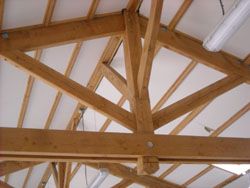Question
I've been making bevel-edge in-house for a couple years, but recently I've encountered a problem. So far I've always used 1/2" MDF in 4" strips, Laminated Wilsonart 107 type HPL with Formica 145 applied with a white foam hotdog roller, then 90deg. ripped the bevel blocks off the sides, 45deg. bevel ripped the faces, taped and glued the mitre with Titebond III Clamped w/ 60 handscrews per 97" in jig, then planed to 3/8" Contact Adhesive set time: 12 hours. Titebond set time: 45 minutes. in jig, then 12 hours on flat shelf.
This worked fine for the longest time. I cannot get 145 locally anymore, so last month I switched to WA600, and my problems started. I'm having problems with my glue-line failing. Specifically, firm fingernail pressure can claw the laminate away from the substrate.
This is not an open time/coverage problem. At first, the line failed after final planing. I'd get spots with loose HPL with approximately 1/64 of fiber attached. I suspected that hard use of the planer by a new employee had worn the blades to the point that the rollers were shoving the HPL off the MDF at the sharp edge.
Then things got worse, I started getting delamination and weak spots at the table saw. I looked and noticed that I wasn't having adhesion problems, there was a rind of MDF clinging to the HPL. I checked my stock of MDF with a micrometer, and noticed 10% swelling. I said aha! I figured that ambient humidity had weakened the exposed faces of the substrate over time during storage. I purged all my supplies, and bought fresh MDF. Still failure! I changed contact adhesive to Weldwood brand (I know, I know) and still no good. I tried re-blending the adhesives 30 minutes in a shaker, because I've noticed some greasy booger action from one of the WA600 cans.
I think what's happening is that components of the adhesive are saturating deep, and dissolving the UForm. adhesive in the MDF, but not re-bonding. Or, the quality of the MDF available to has suddenly dropped in quality, like OSB in the 90ís. Does anybody have an intimate familiarity with this distinct problem, and know the cause? I'm not looking for an easy answer here.
Forum Responses
(Adhesive Forum)
From Jeff Pitcher, forum technical advisor:
I think you've hit on a very topical problem. Lately I've seen the same thing you described with both mdf and particle board. The board industry is under tremendous pressure to lower the amount of formaldehyde in their boards. I believe that this has resulted in a lot of board being on the market with substandard faces. This is only a guess on my part and I doubt anyone from the board industry would substantiate it, but until I have a better explanation I'll stand by it.
